SHAOLIN WAHNAM KUNGFU — COMBAT SEQUENCE 12
“NAUGHTY MONKEY KICKS AT TREE”
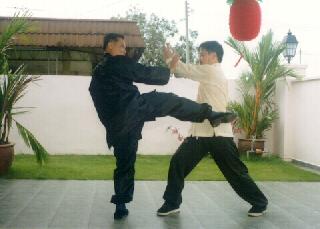
Naughty Monkey Kicks at Tree
Various Ways of Intercepting an Opponent's Attacks
Applying the tactic of pressing attacks is a very effective way to defeat an opponent, especially when his combat training consists only of free sparring. Free sparring, it is helpful to remember, was never used by traditional kungfu masters to train combat — a fact many martial artists today must be very surprised to know. That does not mean there was no free sparring in kungfu history.
In fact free sparring was an essential part of traditional kungfu training. It was known as “san da”, which literally means “miscellaneous fighting”, i.e. fighting not based on planned routines. San da or free sparring was used to test — not to train — combat efficiency.
Due to various reasons, the methodology to train combat efficiency has been generally lost. The great majority of kungfu practitioners today only practice solo kungfu sets. This situation was much aggravated when traditional kungfu evolved into modern wushu, which is now practiced as a demonstrative sport, and not as a fighting art.
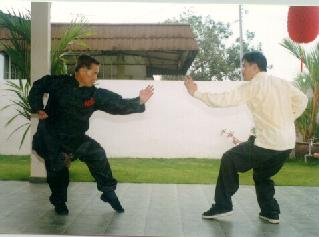
|
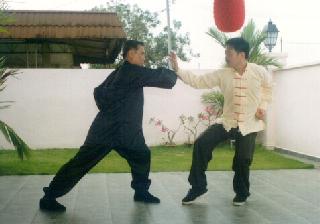
|
| Poise Patterns | Black Tiger |
As officials of wushu organizations became embarrassed at the inability of modern wushu for combat, san da was introduced. But because wushu as well as most kungfu practitioners cannot apply their techniques in combat, they resort to Taekwondo, Kickboxing or free-style fighting.
We at Shaolin Wahnam are extremely lucky that we still have the traditional methodology to train combat using typical kungfu skills and techniques. We should persevere in our training so that this methodology, which has been proven to be effective, will not be lost.
We have learned that we can intercept pressing attacks in many ways and at different points. In the previous sequence, Sequence 11, we intercepted an opponent's pressing attacks as soon as he has made his first move. In this sequence, we are even faster; we intercept him and counter-attack while he is still in the process of his first attack.
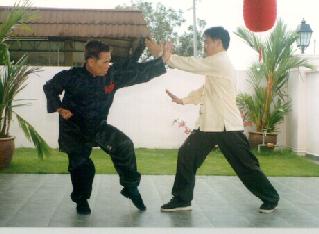
|

|
| Golden Dragon | Naughty Monkey |
This is technically faster and therefore more effective than intercepting an opponent after he has made a few moves. Then, why do we still practice the other methods. There are a few reasons, and two important ones are that the other methods help us to develop our skills progressively, and that there are conditions when intercepting an opponent at a later stage is more advantageous.
Of course the techniques presented here — “Single Tiger” followed by “Chop the Hua Mountain” — are used not just for intercepting pressing attacks. If you have practiced these two techniques well, you can defeat an opponent as soon as he attacks you. First you practice them as two separate patterns, which will take three movements — retreating to “Single Tiger”, covering the opponent's elbow, and moving forward to strike him with “Chop the Hua Mountain”. This involves the tactic “first defence then counter”.
Gradually you progress to just one smooth movement — adjusting your footwork to strike him with “Chop the Hua Mountain”, covering his attack in the process. This involves the tactic “defence cum counter”.
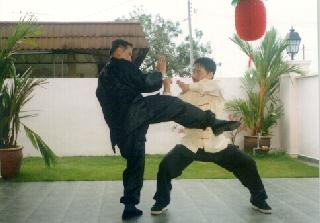
|
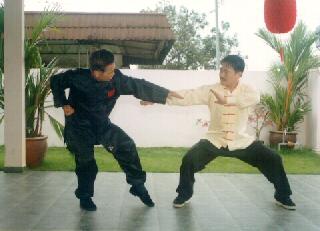
|
| Bar Big Boss | Precious Duck |
The counter against the whirlwind kick presented here is comparatively hard. You must be aware that your head is exposed. This is a weakness for untrained combatants. But if you are aware of this innate weakness, and able to turn the table round against your opponent should he attack your head, you can reverse the weakness into an advantage. But we shall leave that to later lessons.
An alternative counter, which is better for beginners, is to slant your body backward into the pattern “Tame Tiger with String of Beads”. As his kick is spent, brush away his leg, shift your body forward and strike him with “Precious Duck Swims through Lotus” or “Golden Leopard Speeds through Jungle”.
You may have noticed that as you advance in your combat training, the combat sequences become shorter. This is to provide you with better opportunities to make your own modifications, changes or continuation, as part of the progression to eventual free sparring.
This sequence completes the set of Combat Sequences 9 to 12 for kicking attacks and defences. These four sequences make up the kungfu set “Happy Bird Hops up Branch”.
OVERVIEW

|

|

|
| Poise Patterns | Black Tiger | Golden Dragon |

|

|

|
| Naughty Monkey | Bar Big Boss | Precious Duck |
LINKS
Other Combat Sequences
Hand Attacks- Combat Sequence 1: Black Tiger Steals Heart — Pictures
- Combat Sequence 2: White Snake Shoots Venom — Pictures
- Combat Sequence 3: Precious Duck Swims Through Lotus — Pictures
- Combat Sequence 4: Hang a Golden Star at a Corner — Pictures
- Combat Sequence 5: Fierce Tiger Speeds Through Valley — Pictures
- Combat Sequence 6: Dark Dragon Draws Water — Pictures
- Combat Sequence 7: Chop the Hua Mountain — Pictures
- Combat Sequence 8: Horizontally Sweep a Thousand Armies — Pictures
Leg Attacks
- Combat Sequence 9: Happy Bird Hops up Branch — Pictures
- Combat Sequence 10: White Horse Presents Hoof — Pictures
- Combat Sequence 11: Yellow Bird Plays with Water — Pictures
- Combat Sequence 12: Naughty Monkey Kicks at Tree — Pictures
Felling and Gripping Attacks
- Combat Sequence 13: Fell Tree with Roots — Pictures
- Combat Sequence 14: Lead Horse Back to Stable — Pictures
- Combat Sequence 15: Farmer Hoes Rice Field — Pictures
- Combat Sequence 16: Fierce Tiger Pushes Mountains — Pictures
